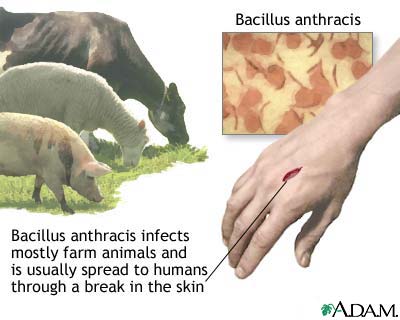Alternate Names : Anthrax – skin
Definition
Cutaneous anthrax is an infection of the skin due to direct contact with the bacteria Bacillus anthracis.
Overview, Causes, & Risk Factors
Anthrax is caused by the bacteria Bacillus anthracis. While anthrax commonly affects hoofed animals such as sheep and goats, humans may get sick from anthrax, too. The most common type of anthrax infection in people is cutaneous anthrax, an infection of the skin.
The main risk factor for getting cutaneous anthrax is contact with animal hides or hair, bone products, and wool, as well as contact with infected animals. Therefore, those most at risk for anthrax include farm workers, veterinarians, and tannery and wool workers.
Cutaneous anthrax occurs after the bacteria touch a cut or scrape on the skin.
Anthrax is a potential agent for use as a biological weapon or for bioterrorism. In 2001, bioterrorist activities involving the United States Postal Service infected 22 people with anthrax. Seven survivors had confirmed cases of cutaneous anthrax. Most bioterrorism experts have concluded that it is technologically difficult to use anthrax effectively as a weapon on a large scale.
Pictures & Images
Cutaneous anthrax
 Anthrax is caused by the bacteria Bacillus anthracis. While anthrax commonly affects hoofed animals such as sheep and goats, humans may get sick from anthrax, too. The most common type of anthrax infection is cutaneous anthrax, an infection of the skin.
Anthrax is caused by the bacteria Bacillus anthracis. While anthrax commonly affects hoofed animals such as sheep and goats, humans may get sick from anthrax, too. The most common type of anthrax infection is cutaneous anthrax, an infection of the skin.
Cutaneous anthrax

Cutaneous anthrax is an infection of the skin caused by the bacterium Bacillus anthracis. The bacteria causes disease when it comes into contact with non-intact skin. During an infection, an initial skin lesion forms then blisters. The blister breaks down into a black ulcer and nearby lymph nodes may become infected and painful. A scar is often formed which then dries and falls off within two weeks. In 20% of untreated individuals, the infection may spread to the bloodstream and become fatal. Although with proper treatment, death is extremely rare.
Skin layers

The skin is the largest organ of the body. The skin and its derivatives (hair, nails, sweat and oil glands) make up the integumentary system. One of the main functions of the skin is protection. It protects the body from external factors such as bacteria, chemicals, and temperature. The skin contains secretions that can kill bacteria and the pigment melanin provides a chemical pigment defense against ultraviolet light that can damage skin cells. Another important function of the skin is body temperature regulation. When the skin is exposed to a cold temperature, the blood vessels in the dermis constrict. This allows the blood which is warm, to bypass the skin. The skin then becomes the temperature of the cold it is exposed to. Body heat is conserved since the blood vessels are not diverting heat to the skin anymore. Among its many functions the skin is an incredible organ always protecting the body from external agents.
-
Cutaneous anthrax : Overview, Causes, & Risk Factors
-
Cutaneous anthrax : Symptoms & Signs, Diagnosis & Tests
-
Cutaneous anthrax : Treatment



Review Date : 10/28/2008
Reviewed By : Michael Lehrer, M.D., Department of Dermatology, University of Pennsylvania Medical Center, Philadelphia, PA. Review provided by VeriMed Healthcare Network. Also reviewed by David Zieve, MD, MHA, Medical Director, A.D.A.M., Inc.
